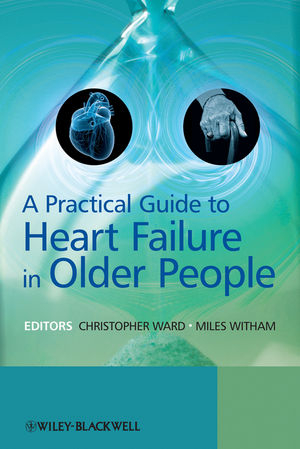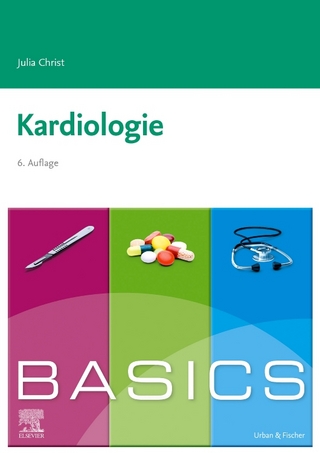
A Practical Guide to Heart Failure in Older People
John Wiley & Sons Inc (Verlag)
978-0-470-69517-3 (ISBN)
- Titel z.Zt. nicht lieferbar
- Versandkostenfrei innerhalb Deutschlands
- Auch auf Rechnung
- Verfügbarkeit in der Filiale vor Ort prüfen
- Artikel merken
These important age-related treatment and management problems have been largely ignored and this book aims to redress the balance. It provides a concise, comprehensive account of the epidemiology, pathogenesis, diagnosis, treatment, management and end-of-life care of elderly patients with heart failure, based on published studies.
A Practical Guide to Heart Failure in Older People is essential reading for geriatricians, cardiologists, general hospital physicians, family practitioners and specialist nurses.
• Specifically addresses the particular needs of the elderly, a largely ignored group who constitute the majority of patients with heart failure
• Presents a concise yet comprehensive account of the evidence relating to the diagnosis, treatment and management of heart failure in this population
• Improves awareness of the various roles within the management team
Chris Ward and Miles Witham are the authors of A Practical Guide to Heart Failure in Older People, published by Wiley.
Preface xi
List of Contributors xiii
1 Introduction 1
Christopher Ward
1.1 A Working Definition of Heart Failure 1
1.2 What do We Mean by ‘Older People?’ 2
1.3 The Expectations of Older Patients 4
1.4 Age-Related Problems in Heart Failure Treatment and Management 4
1.5 The Level of Evidence for Treating Older Patients 6
References 7
2 Epidemiology 9
Christopher Ward
2.1 Epidemiology, Demography and Prognosis 9
2.2 Heart Failure with Preserved Left Ventricular Systolic Function (HF-PSF) 10
2.3 Prevalence, Incidence and Prognosis 11
2.4 Age and Prognosis 14
2.5 The Effects of Gender and Race on Prevalence and Prognosis 18
2.6 The Increasing Prevalence of Heart Failure and Longevity 19
2.7 The Implications of Epidemiological and Demographic Data 20
References 22
3 Heart Failure and the Aging Heart 27
Helen Oxenham
3.1 Introduction 27
3.2 Overt and Subclinical Cardiovascular Disease in Older People 28
3.3 Age-Related Changes to Cardiac Structure and Function 33
3.4 Other Relevant Age-Related Changes 35
3.5 Responses of the Aging Cardiovascular System to Exercise, Normal Daily Activities and to Other Physiological Stresses 36
3.6 The Pathogenesis of Heart Failure 38
3.7 The Impact of Age-Related Changes to the Cardiovascular System on the Responses to Myocardial Damage 40
3.8 The Prevention of Heart Failure in Older People 40
References 41
4 Aetiology 45
Christopher Ward
4.1 Classification of the Aetiologies of Heart Failure 45
4.2 The Importance of Identifying the Aetiology 47
4.3 Specific Aetiologies 48
4.4 Post-Myocardial Infarction (Post-MI) Heart Failure 49
4.5 Valvular Disease 51
4.6 The Cardiomyopathies 56
4.7 Atrial Fibrillation 57
References 58
5 Diagnosis 63
Christopher Ward
5.1 Diagnostic Guidelines 64
5.2 Symptoms and Signs: Sensitivity and Specificity 65
5.3 Objective Evidence of Left Ventricular Systolic Dysfunction 66
5.4 Diagnostic Difficulties in Older Patients 70
5.5 Diagnosis, Patient Management and Clinical Profile 73
References 76
6 Pharmacological Treatment 79
Miles D. Witham
6.1 Introduction 79
6.2 ACE Inhibitors 81
6.3 Beta-Blockers 83
6.4 Spironolactone 85
6.5 Diuretics 87
6.6 Digoxin 88
6.7 Hydralazine and Nitrates 89
6.8 Adding Angiotensin Receptor Blockers to ACE Inhibitors 90
6.9 Treating the Underlying Cardiovascular Disease 90
6.10 Medications to Avoid 90
6.11 Prescribing for Heart Failure with Preserved Systolic Function 92
6.12 Prescribing for Multiple Comorbidities 92
6.13 Prescribing at the End of Life 93
References 93
7 Non-Pharmacological Management 97
Sinéad P. McKee and Miles D. Witham
7.1 Exercise Training 97
7.2 Types of Exercise Programme 98
7.3 Smoking 100
7.4 Diet 101
7.5 Alcohol 103
7.6 Vaccinations 104
7.7 Psychological Interventions 104
References 104
8 Comorbidity 107
Andrew Elder
8.1 Introduction 107
8.2 The Prevalence of Comorbidities 109
8.3 The Implications of Comorbidity 109
8.4 Specific Comorbidities in Heart Failure 111
References 127
9 Treatment and Management in Primary Care 133
Alan Begg
9.1 Introduction 134
9.2 The Role of Primary Care and the Patient Population 134
9.3 Heart Failure Registers, Data Collection and Audit 135
9.4 Heart Failure in General Practice 140
9.5 Treatment and Management 146
9.6 Specific Problems in Treating Older Patients 150
References 152
10 The Role of the Specialist Nurse 157
Sinéad P. McKee
10.1 Introduction 157
10.2 The Role of the Specialist Nurse 158
10.3 Clinic-Based versus Home-Based Service 163
10.4 Multidisciplinary Team Liaison 165
10.5 Specific Issues Affecting Older Patients 166
10.6 End of Life Care 169
10.7 Specialist Nurses and Education 169
References 171
11 The Role of the Heart Failure Specialist 175
Maheshwar Pauriah, Aaron K.F. Wong and Chim C. Lang
11.1 Introduction 175
11.2 The Role of the Heart Failure Specialist 176
11.3 The Provision of a Diagnostic Service and Patient Assessment 177
11.4 Management of Patients with Acute or Worsening Heart Failure Symptoms 178
11.5 Optimization of Heart Failure Treatment 180
11.6 Treatment of Reversible Causes of Heart Failure 184
11.7 Treatment of Concomitant Diseases 187
11.8 Multidisciplinary Care 189
References 191
12 Hospitalization 197
Andrew Hannah
12.1 The Epidemiology of Hospitalization 197
12.2 The Aetiology of Heart Failure in Hospitalized Patients 198
12.3 Classification and Diagnosis of Acute Heart Failure (AHF) 199
12.4 Causes and Precipitants of Hospitalization 201
12.5 Treatment of Acute Heart Failure 205
12.6 Management of the Common Cardiac Causes of Hospitalization for Heart Failure 208
12.7 Outcomes in Patients Hospitalized for Heart Failure 209
12.8 Strategies to Reduce Admissions and Readmissions in Patients with Heart Failure 210
References 211
13 Models of Care and Disease Management Programmes 215
Martin Wilson and Stephen J. Leslie
13.1 Introduction 215
13.2 Disease Management Programmes 218
13.3 Disease Management Programmes: The Evidence 227
13.4 Guidelines and Critical Care Pathways 228
13.5 Remote and Rural Issues 231
13.6 Telecardiology in Heart Failure 232
13.7 Conclusions 235
References 235
14 Palliative and Supportive Care for Patients with Advanced and Terminal Heart Failure 241
Christopher Ward, Francis G. Dunn, Shona M.M. Jenkins and Martin Leiper
14.1 What is Palliative Care? 242
14.2 Age-Related Problems and the Provision of Palliative Care 243
14.3 Advanced and Terminal Heart Failure 244
14.4 Management of Specific Symptoms 248
14.5 Home and Hospital Care 253
14.6 Withdrawal of Conventional Drugs 254
14.7 The Palliative Care Needs of Heart Failure Patients 254
14.8 Palliative Care Strategies for Heart Failure 256
14.9 Timing the Introduction of Different Palliative Care Strategies 256
14.10 Cardiological Issues 259
14.11 The Management Implications of Advanced Heart Failure 260
14.12 Control of Symptoms Using Mostly Generic Treatments 261
14.13 Support in the Community: The Gold Standard Framework (GSF) and Advanced Care Planning (ACP) 262
14.14 Terminal Heart Failure: Identifying the Dying Patient and Providing End-of-Life Care 263
References 265
Index 271
| Erscheint lt. Verlag | 1.6.2009 |
|---|---|
| Verlagsort | New York |
| Sprache | englisch |
| Maße | 177 x 249 mm |
| Gewicht | 624 g |
| Themenwelt | Medizinische Fachgebiete ► Innere Medizin ► Kardiologie / Angiologie |
| ISBN-10 | 0-470-69517-X / 047069517X |
| ISBN-13 | 978-0-470-69517-3 / 9780470695173 |
| Zustand | Neuware |
| Haben Sie eine Frage zum Produkt? |
aus dem Bereich


